
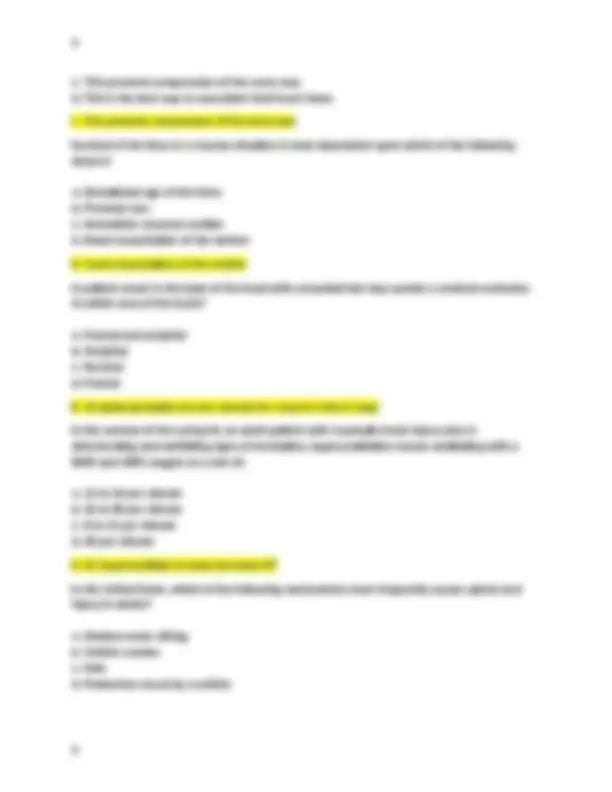
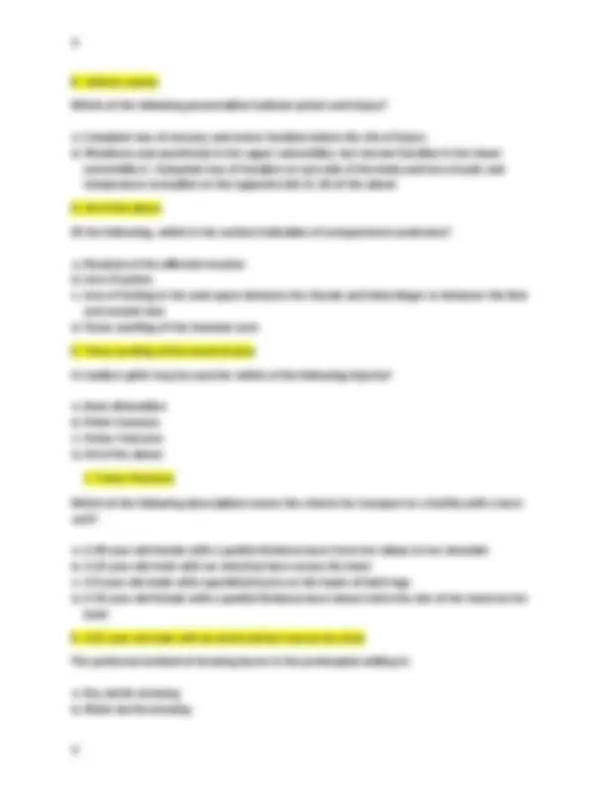
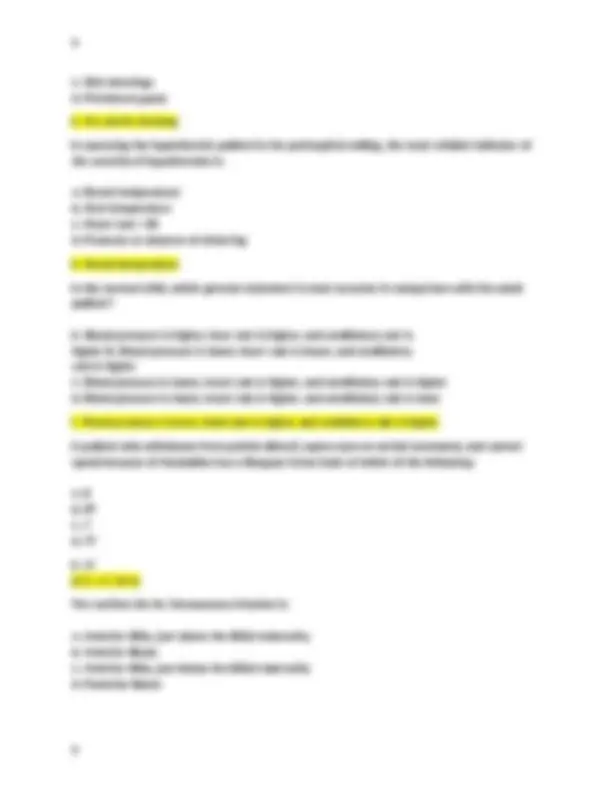
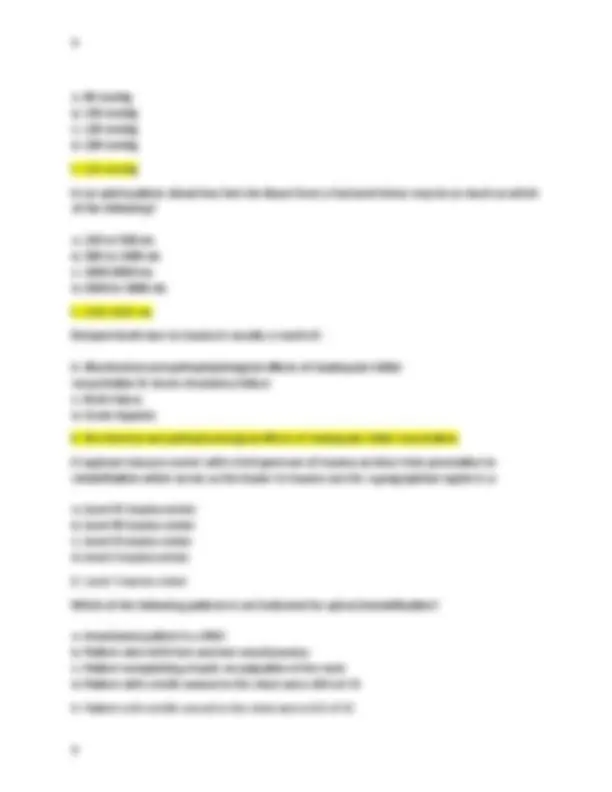
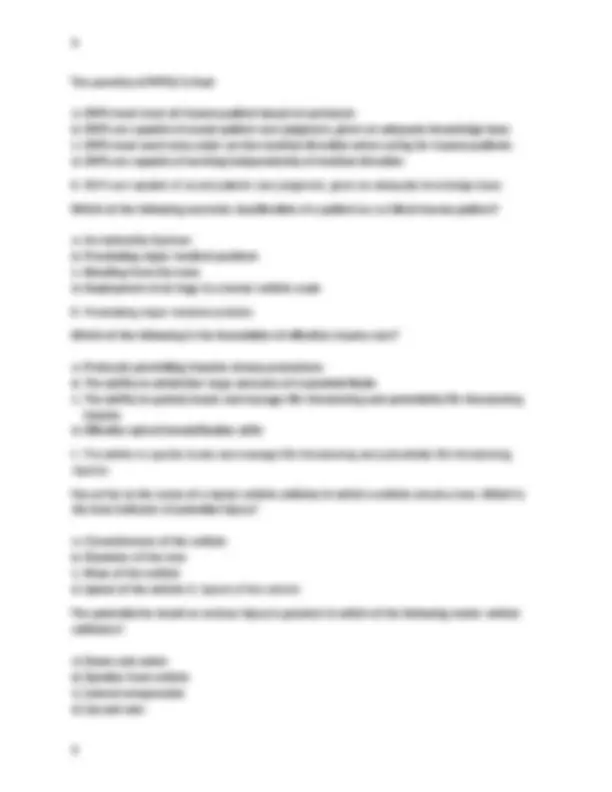

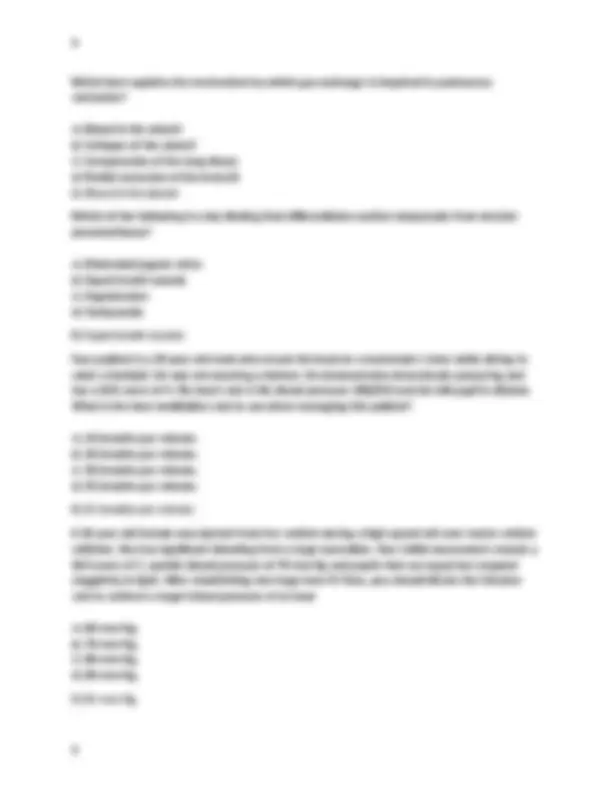
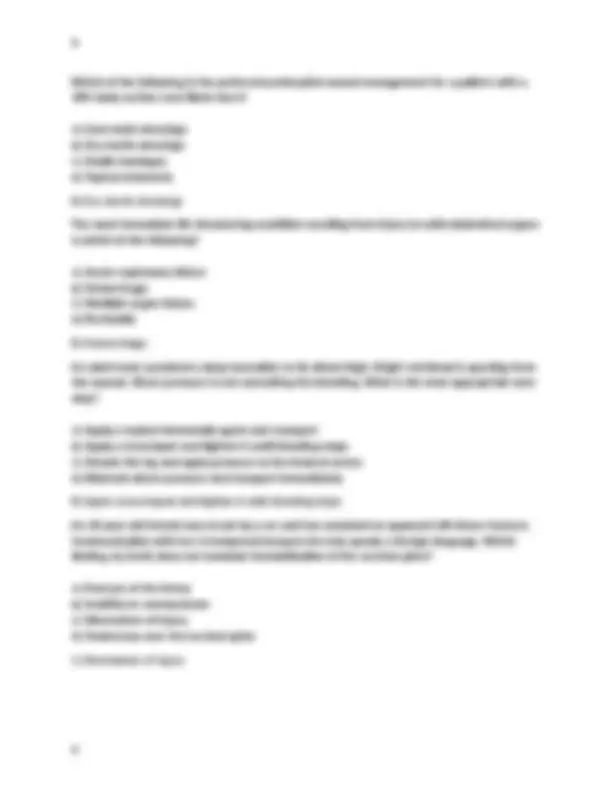




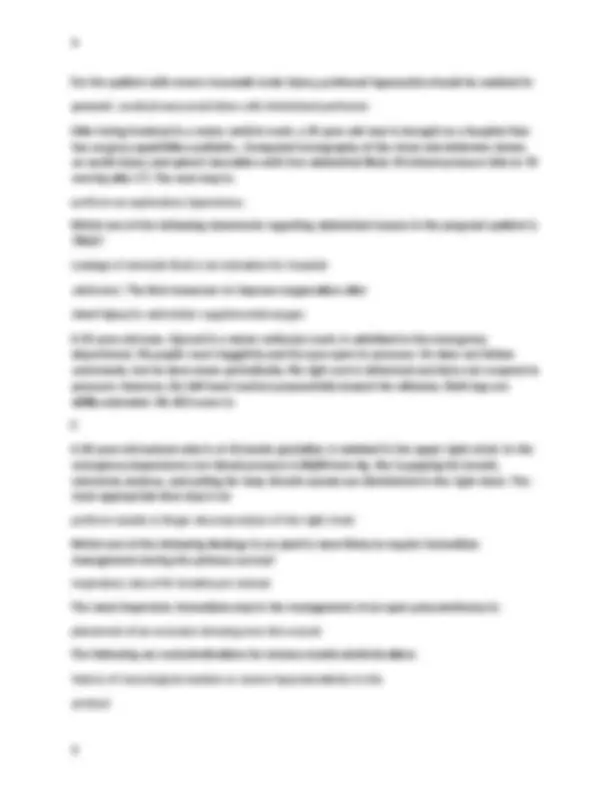
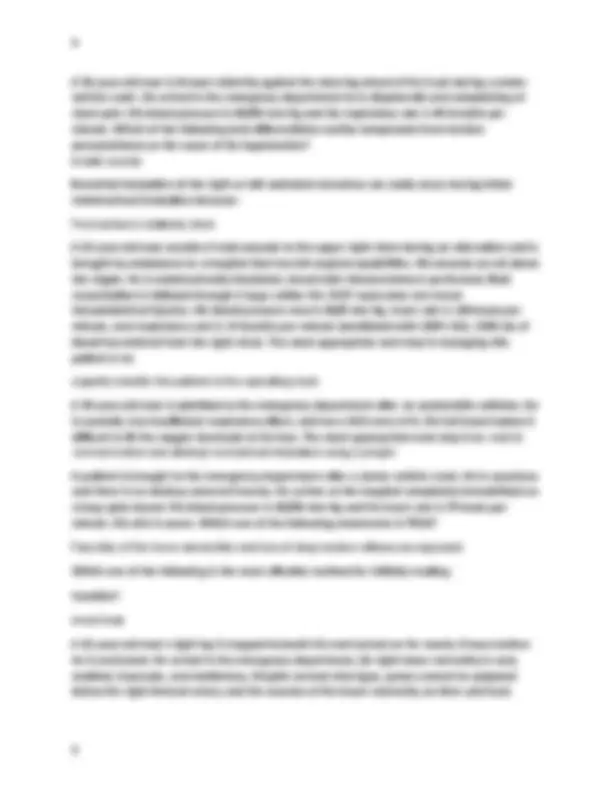
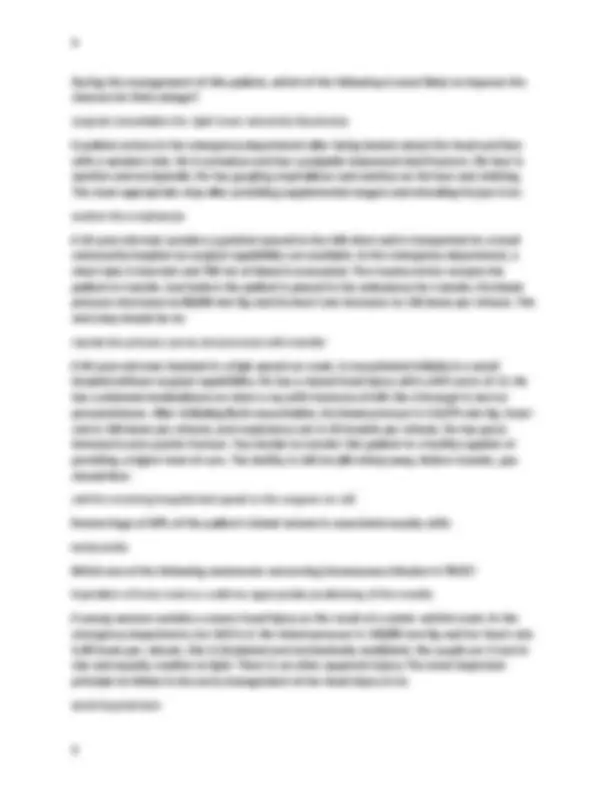
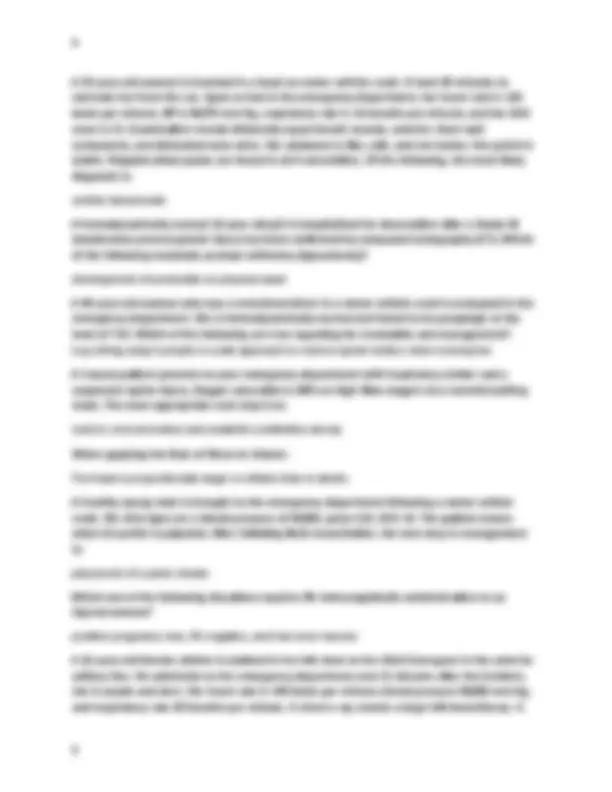
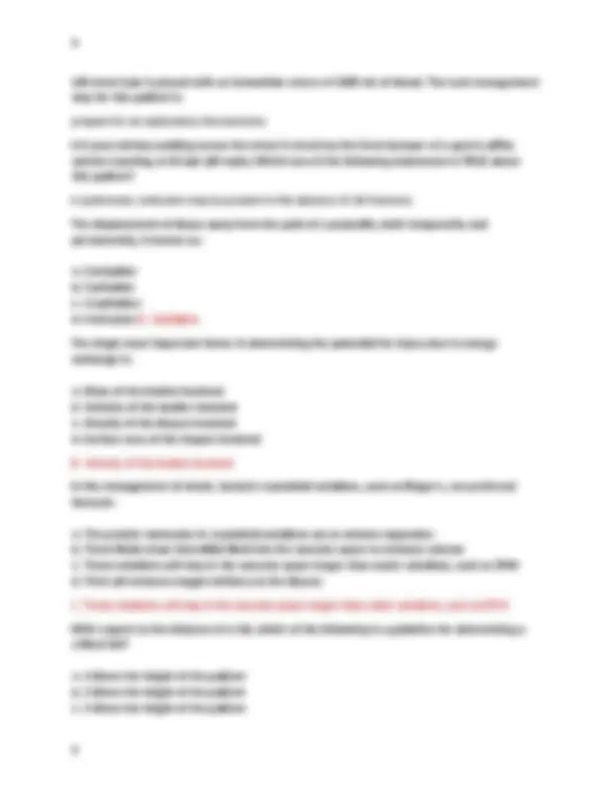





Study with the several resources on Docsity

Earn points by helping other students or get them with a premium plan


Prepare for your exams
Study with the several resources on Docsity

Earn points to download
Earn points by helping other students or get them with a premium plan
Community
Ask the community for help and clear up your study doubts
Discover the best universities in your country according to Docsity users
Free resources
Download our free guides on studying techniques, anxiety management strategies, and thesis advice from Docsity tutors
Which of the following is NOT a component of the Fick Principle? A. Adequate number of platelets in the blood B. Oxygenation of red blood cells C. Transportation of red blood cells to the tissues of the body D. Off-loading oxygen from the red blood cells to the tissues A. Adequate number of platelets in the blood One of the earliest signs of hypovolemic shock is: A. Hypotension B. Bradycardia C. Anxiety D. Reduced urine output C. Anxiety Which of the following characterizes the washout phase of shock? A. Systemic acidosis B. Localized tissue acidosis C. Edema D. Reduced capillary blood flow A. Systemic acidosis
Typology: Exams
1 / 28

This page cannot be seen from the preview
Don't miss anything!





















Which of the following is NOT a component of the Fick Principle? A. Adequate number of platelets in the blood B. Oxygenation of red blood cells C. Transportation of red blood cells to the tissues of the body D. Off-loading oxygen from the red blood cells to the tissues A. Adequate number of platelets in the blood One of the earliest signs of hypovolemic shock is: A. Hypotension B. Bradycardia C. Anxiety D. Reduced urine output C. Anxiety Which of the following characterizes the washout phase of shock? A. Systemic acidosis B. Localized tissue acidosis C. Edema D. Reduced capillary blood flow A. Systemic acidosis A trauma patient who has fallen 20 feet from an apartment balcony is alert with warm, dry, pink skin, with normal capillary refilling time to the lower extremities, and is hypotensive. The
upper extremities are cool, pale and diaphoretic. Which of the following injuries should be suspected? A. Aortic dissection B. Liver laceration C. Fractured pelvis D. Spinal cord injury D. Spinal cord injury Which of the following is a limitation of prehospital fluid resuscitation of the patient in hemorrhagic shock? A. Inability of fluids to carry oxygen B. Pulmonary edema C. Increased hemorrhage D. All of the above D. All of the above Which of the following statements regarding signs of intraabdominal injury is NOT true? A. Fresh blood in the abdominal cavity does not cause signs of peritonitis B. A significant amount of blood loss occurs before abdominal distention can be noticed C. Substantial intraabdominal hemorrhage always causes tenderness and abdominal rigidity D. Signs and symptoms of shock greater than can be explained by other injuries is a reliable indicator of intraabdominal injury C. Substantial intraabdominal hemorrhage always causes tenderness and abdominal rigidity Which of the following assessment techniques is least useful in the prehospital assessment of the patient with suspected intraabdominal trauma? A. Palpation B. Auscultation C. Inspection D. Scene assessment B. Auscultation Pregnant trauma patients should be placed on the left side because: A. This prevents seizures due to eclampsia B. This prevents abruption of the placenta
B. Vehicle crashes Which of the following presentation indicate spinal cord injury? A. Complete loss of sensory and motor function below the site of injury B. Weakness and parethesia in the upper extremities, but normal function in the lower extremities C. Complete loss of function on one side of the body and loss of pain and temperature sensation on the opposite side D. All of the above D. All of the above Of the following, which is the earliest indication of compartment syndrome? A. Paralysis of the affected muscles B. Loss of pulses C. Loss of feeling in the web space between the thumb and index finger or between the first and second toes D. Tense swelling of the involved area D. Tense swelling of the involved area A traction splint may be used for which of the following injuries? A. Knee dislocation B. Pelvic fractures C. Femur fractures D. All of the above C. Femur fractures Which of the following descriptions meets the criteria for transport to a facility with a burn unit? A. A 49 year old female with a partial thickness burn from her elbow to her shoulder B. A 25 year old male with an electrical burn across his chest C. A 9 year old make with superficial burns on the backs of both legs D. A 32 year old female with a partial thickness burn about twice the size of her hand on her back B. A 25 year old male with an electrical burn across his chest The preferred method of dressing burns in the prehospital setting is: A. Dry sterile dressing B. Moist sterile dressing
C. Wet dressings D. Petroleum gauze A. Dry sterile dressing In assessing the hypothermic patient in the prehospital setting, the most reliable indicator of the severity of hypothermia is: A. Rectal temperature B. Oral temperature C. Heart rate < 60 D. Presence or absence of shivering A. Rectal temperature In the normal child, which general statement is most accurate in comparison with the adult patient? A. Blood pressure is higher, hear rate is higher, and ventilatory rate is higher B. Blood pressure is lower, heart rate is lower, and ventilatory rate is higher C. Blood pressure is lower, heart rate is higher, and ventilatory rate is higher D. Blood pressure is lower, heart rate is higher, and ventilatory rate is lowe C. Blood pressure is lower, heart rate is higher, and ventilatory rate is higher A patient who withdraws from painful stimuli, opens eyes on verbal command, and cannot speak because of intubation has a Glasgow Coma Scale of which of the following: A. 8 B. 8T C. 7 D. 7T B. 8T (E-3, V-T, M-4) The earliest site for intraosseous infusion is: A. Anterior tibia, just above the tibial tuberosity B. Anterior fibula C. Anterior tibia, just below the tibial tuberosity D. Posterior fibula
C. Increased intrathoracic pressure D. Blood and fluid in the alveoli and interstitial spaces of the lung D. Blood and fluid in the alveoli and interstitial spaces of the lung Your patient is a 55 year old male who was struck in the right side of the chest with a piece of steel pipe. He presents with uncooperative behavior, his skin is pale and moist, the ventilatory rate is 32, there is a weak radial pulse of 112, and breath sounds are decreased on the right side. The trachea is midline and jugular veins are flat while the patient is supine. There is isolated crepitus over the 4th and 5th ribs in the midaxillary line on the patient's right side. Based on the mechanism of injury and the assessment findings, which of the following is the most likely cause of the patient's signs and symptoms? A. Tension pneumothorax B. Simple pneumothorax C. Pulmonary contusion D. Hemothorax D. Hemothorax Deterioration of ventilation and oxygenation after inflation of a PASG in a patient who has sustained a high-pressure compression injury of the abdomen, such as a sudden deceleration with the lap belt placed across the abdomen, most likely represents which of the following injuries? A. Abdominal aortic aneurysm B. Ruptured diaphragm C. Ruptured esophagus D. "Paper bag" syndrome of the lungs B. Ruptured diaphragm Which of the following behaviors is the most reliable indication of confusion in the elderly trauma patient? A. Inability to recall his/her name B. Inability to recall the day of the week C. Inability to identify his/her present location when out of his/her normal residence D. Focus on repeated retelling of events that occurred years ago A. Inability to recall his/her name In the elderly trauma patient a high index of suspicion for shock should occur beginning when the systolic blood pressure is less than:
A. 90 mmHg B. 150 mmHg C. 120 mmHg D. 100 mmHg C. 120 mmHg In an adult patient, blood loss into the tissue from a fractured femur may be as much as which of the following? A. 150 to 500 mL B. 500 to 1000 mL C. 1000 2000 mL D. 2500 to 5000 mL C. 1000 2000 mL Delayed death due to trauma is usually a result of: A. Biochemical and pathophysiological effects of inadequate initial resuscitation B. Acute circulatory failure C. Brain injury D. Acute hypoxia A. Biochemical and pathophysiological effects of inadequate initial resuscitation A regional resource center with a full spectrum of trauma services from prevention to rehabilitation which serves as the leader in trauma care for a geographical region is a: A. Level IV trauma center B. Level III trauma center C. Level II trauma center D. Level I trauma center D. Level I trauma center Which of the following patients is not indicated for spinal immobilization? A. Intoxicated patient in a MVC B. Patient who fell 8 feet and lost consciousness C. Patient complaining of pain on palpation of the neck D. Patient with a knife wound to the chest and a GCS of 15 D. Patient with a knife wound to the chest and a GCS of 15
B) Ejection from vehicle Bilateral femur fractures are most often associated with which type of motorcycle crash? A) Angular impact B) Bike-road impact C) Head-on impact D) Rear impact C) Head-on impact Which is the preferred fluid for resuscitation of hemorrhagic shock in the prehospital setting? A) 5% dextrose in water B) 7.5% hypertonic saline C) Hetastarch D) Lactated Ringer's D) Lactated Ringer's Which is the most common cause of upper airway obstruction in the trauma patient? A) Blood B) Teeth C) Tongue D) Vomitus C) Tongue Which is the preferred adjunct device for verifying placement of an endotracheal tube in a patient with a perfusing rhythm? A) End-tidal CO2 monitoring (capnography) B) Esophageal detector device C) Pulse oximeter D) Stethoscope A) End-tidal CO2 monitoring (capnography) Which is the most important reason to maintain an open airway in the trauma patient? A) Prevents aspiration and pneumonia B) Prevents hypoxemia and hypercarbia C) Prevents snoring respirations D) Prevents the tongue from blocking the pharynx
B) Prevents hypoxemia and hypercarbia Essential airway skills include manual clearing of the airway, manual maneuvers, suctioning and which of the following? A) Dual lumen airway B) Endotracheal intubation C) Laryngeal mask airway D) Oropharyngeal airway D) Oropharyngeal airway Your patient is a middle aged male who crashed his motorcycle. He is unresponsive. After opening the airway using a modified jaw thrust, you note the patient has respirations at a rate of 6. Auscultation reveals breath sounds are absent on the left side. Which of the following is the most appropriate next intervention? A) Apply a non-rebreather mask B) Begin ventilation with a BVM C) Insert an endotracheal tube D) Perform a needle decompression B) Begin ventilation with a BVM Which best describes shock? A) Decreased Glasgow Coma Scale (GCS) B) Flushed, dry, hot skin combined with bradycardia C) Generalized inadequate tissue perfusion D) Low blood pressure combined with tachycardia C) Generalized inadequate tissue perfusion Your patient has a deep laceration to his antecubital fossa with significant bleeding. What is the most appropriate initial action? A) Apply a tourniquet B) Apply direct pressure C) Initiate rapid transport D) Restore blood volume B) Apply direct pressure Hypotension of unknown etiology in a trauma patient should be assumed to result from which of the following?
Which best explains the mechanism by which gas exchange is impaired in pulmonary contusion? A) Blood in the alveoli B) Collapse of the alveoli C) Compression of the lung tissue D) Partial occlusion of the bronchi A) Blood in the alveoli Which of the following is a key finding that differentiates cardiac tamponade from tension pneumothorax? A) Distended jugular veins B) Equal breath sounds C) Hypotension D) Tachycardia B) Equal breath sounds Your patient is a 20 year old male who struck his head on a teammate's knee while diving to catch a football. He was not wearing a helmet. He demonstrates decerebrate posturing and has a GCS score of 4. His heart rate is 58, blood pressure 180/102 and his left pupil is dilated. What is the best ventilation rate to use when managing this patient? A) 10 breaths per minute. B) 20 breaths per minute. C) 30 breaths per minute. D) 35 breaths per minute. B) 20 breaths per minute A 20 year old female was ejected from her vehicle during a high speed roll-over motor vehicle collision. She has significant bleeding from a large laceration. Your initial assessment reveals a GCS score of 7, systolic blood pressure of 70 mm Hg and pupils that are equal but respond sluggishly to light. After establishing two large bore IV lines, you should titrate the infusion rate to achieve a target blood pressure of at least A) 60 mm Hg. B) 70 mm Hg. C) 80 mm Hg. D) 90 mm Hg. D) 90 mm Hg.
Which of the following is the preferred prehospital wound management for a patient with a 36% body surface area flame burn? A) Cool moist dressings B) Dry sterile dressings C) Elastic bandages D) Topical ointments B) Dry sterile dressings The most immediate life threatening condition resulting from injury to solid abdominal organs is which of the following? A) Acute respiratory failure B) Hemorrhage. C) Multiple organ failure. D) Peritonitis B) Hemorrhage. An adult male sustained a deep laceration to his distal thigh. Bright red blood is spurting from the wound. Direct pressure is not controlling the bleeding. What is the most appropriate next step? A) Apply a topical hemostatic agent and transport B) Apply a tourniquet and tighten it until bleeding stops C) Elevate the leg and apply pressure to the femoral artery D) Maintain direct pressure and transport immediately B) Apply a tourniquet and tighten it until bleeding stops An 18-year-old female was struck by a car and has sustained an apparent left femur fracture. Communication with her is hampered because she only speaks a foreign language. Which finding, by itself, does not mandate immobilization of the cervical spine? A) Fracture of the femur B) Inability to communicate C) Mechanism of injury D) Tenderness over the cervical spine C) Mechanism of injury
When does BP start to fall in shock Class 3 What is GCS? E- 4 V- 5 M- 6 Eye spont 4 To command 3 To pain 2 None 1 Verbal spont is 5 Verbal confused is 4 Inappropriate 3 Garbling is 2 None is 1 Motor spont is 6 Localize pain is 5 Withdrawal pain is 4 Decorticating (flexion) is 3 Decebrate (extension) is 2 None is 1 Two main reasons to think about why GCS goes down? TBI Hemorrhagic shock Why do you want to put in chest tube before needle decompression? SIMPLE PTX can turn into TENSION PTX When is DPL useful over fast? No ultrasound available. What is LEMON for airway patency Look Evaluate Malay-ATI
Obstruction Neck mobility What is DEFINITIVE airway? Tube in trachea BELOW vocal cords WHEN is surgical airway indicated? When you CANNOT do any other form of airway (2 attempts typically) What is contraindicated with suspicion of basilar skull frx? OPA, put in gastric tube for suction because it can go through up into cranium thru cribiform plate Peds kid with bicycle trauma is most likely goin to be? PANCREATIC injury Organ tear is more common with? Penetrating injury What type of pelvic fracture is binder indicated in Open book If there is BLOOD at the meatus, then what do you need to do? RUG first, because if you do a cyst gram you will be spilling into the abd cavity If patient is unstable, free air/blood on CT, peritoneal signs yield what? EMERGENT laparotomy What lab value is good for assessing hydration in burn patient? URINE OUTPUT How do you determine difference between PTX and tamponade? BREATH SOUNDS Blowing air leak on chest tube is sign of? TRACHEOBRONCHIAL RUPTURE Bowel sounds on chest auscultation are reflective of Diaphragm injury Apical capping and widened mediastinum are reflective of what?
If there is ANY motor or sensory function below level of injury, constitutes as incomplete injury and should be documented appropriately T/F: Stridor is LATE finding of airway damage in burn pt? TRUE Initial management of burn? DRY dressing. NOT moist! Transfer indications for burn? Partial thickness >40% BSA What is dark urine reflective of in burn pt? RHABDO What do you constantly need to replenish burn pt? Cellular losses 2/2 inflammation What is GOAL urine output in burn? 3 - 50mL per hour, BEST assessment of hydration What do you need to monitor for with rewarming in hypothermia ARRYTHMIA MCC of cardiac arrest in kids? HYPOXIA If you fail an IV in a kid what is next step? IO What is crystalloid infusion unit for kids 20/kg Two MCC of geriatric injuries? FALL, MVC A 22-year-old man is hypotensive and tachycardic after a shotgun wound to the left shoulder. His blood pressure is initially 80/40 mm Hg. After initial fluid resuscitation his blood pressure increases to 122/84 mm Hg. His heart rate is now 100 beats per minute and his respiratory rate is 28 breaths per minute. A tube thoracostomy is performed for decreased left chest
breath sounds with the return of a small amount of blood and no air leak. After chest tube insertion, the most appropriate next step is: re-examine the chest A construction worker falls two stories from a building and sustains bilateral calcaneal fractures. In the emergency department, he is alert, vital signs are normal, and he is complaining of severe pain in both heels and his lower back. Lower extremity pulses are strong and there is no other deformity. The suspected diagnosis is most likely to be confirmed by: complete spine x-ray series Which of the following is true regarding the initial resuscitation of a trauma patient? Evidence of improved perfusion after fluid resuscitation could include improvement in Glasgow Coma Scale score on reevaluation. In managing a patient with a severe traumatic brain injury, the most important initial step is to: secure the airway A previously healthy, 70-kg (154-pound) man suffers an estimated acute blood loss of 2 liters. Which one of the following statements applies to this patient? An ABG would demonstrate a base deficit between - 6 and - 10 mEq/L. The physiological hypervolemia of pregnancy has clinical significance in the management of the severely injured, gravid woman by: increasing the volume of blood loss to produce maternal hypotension The best assessment of fluid resuscitation of the adult burn patient is: urinary output of 0.5 mL/kg/hr The diagnosis of shock must include: evidence of inadequate organ perfusion A 7-year-old boy is brought to the emergency department by his parents several minutes after he fell through a window. He is bleeding profusely from a 6-cm wound of his medial right thigh. Immediate management of the wound should consist of: direct pressure on the wound